BSBLDR804: Analysis of Diversity and Inclusion in the Workplace
VerifiedAdded on 2023/04/21
|24
|7028
|202
Homework Assignment
AI Summary
This assignment delves into the crucial aspects of workplace diversity and inclusion, focusing on strategies to promote diversity, factors influencing organizational diversity culture, and the key aspects of effective diversity management. It addresses 10 main diversity issues in the workplace and provides tools for staff training. The assignment further examines key factors in managing diversity in large international organizations, including related topics like gender pay gap and gender identification. It analyzes the importance of leadership, stakeholder relationships, and Australian policies for workplace diversity. The assignment also includes a business report and case study activity, focusing on diversity trends, policy development, staff training, and improvement areas for best practice management, concluding with strategic priorities for stakeholders.
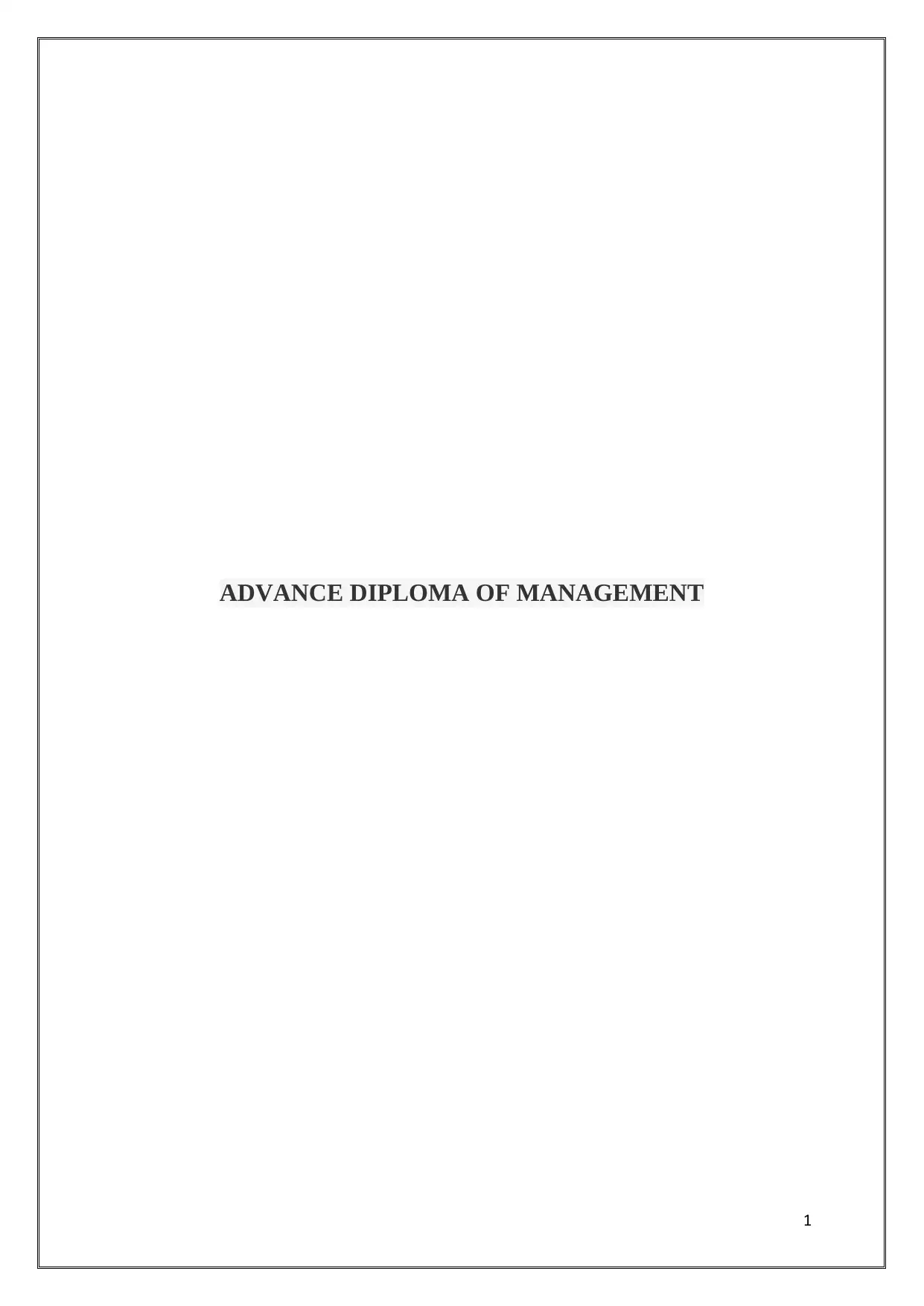
ADVANCE DIPLOMA OF MANAGEMENT
1
1
Paraphrase This Document
Need a fresh take? Get an instant paraphrase of this document with our AI Paraphraser
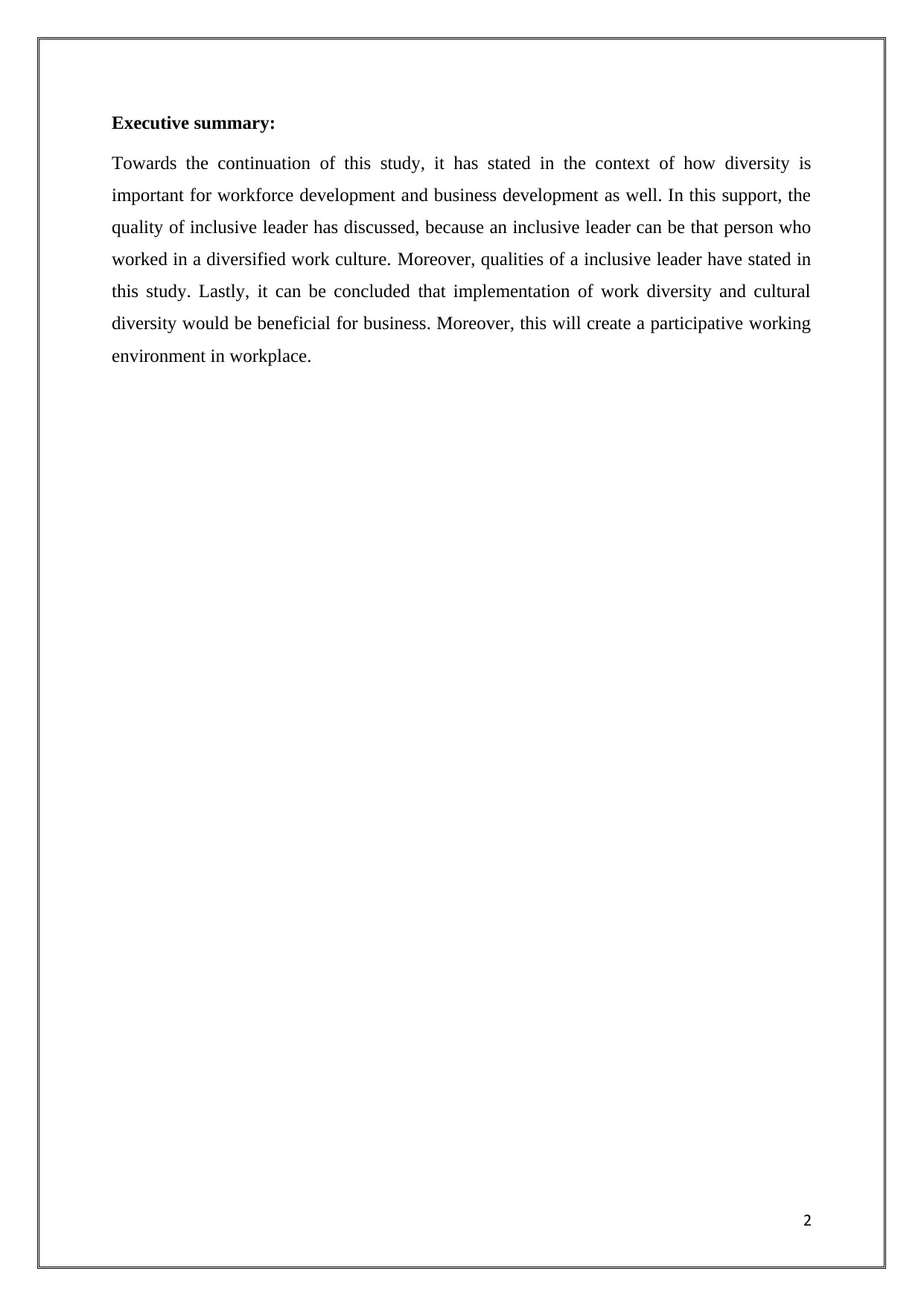
Executive summary:
Towards the continuation of this study, it has stated in the context of how diversity is
important for workforce development and business development as well. In this support, the
quality of inclusive leader has discussed, because an inclusive leader can be that person who
worked in a diversified work culture. Moreover, qualities of a inclusive leader have stated in
this study. Lastly, it can be concluded that implementation of work diversity and cultural
diversity would be beneficial for business. Moreover, this will create a participative working
environment in workplace.
2
Towards the continuation of this study, it has stated in the context of how diversity is
important for workforce development and business development as well. In this support, the
quality of inclusive leader has discussed, because an inclusive leader can be that person who
worked in a diversified work culture. Moreover, qualities of a inclusive leader have stated in
this study. Lastly, it can be concluded that implementation of work diversity and cultural
diversity would be beneficial for business. Moreover, this will create a participative working
environment in workplace.
2
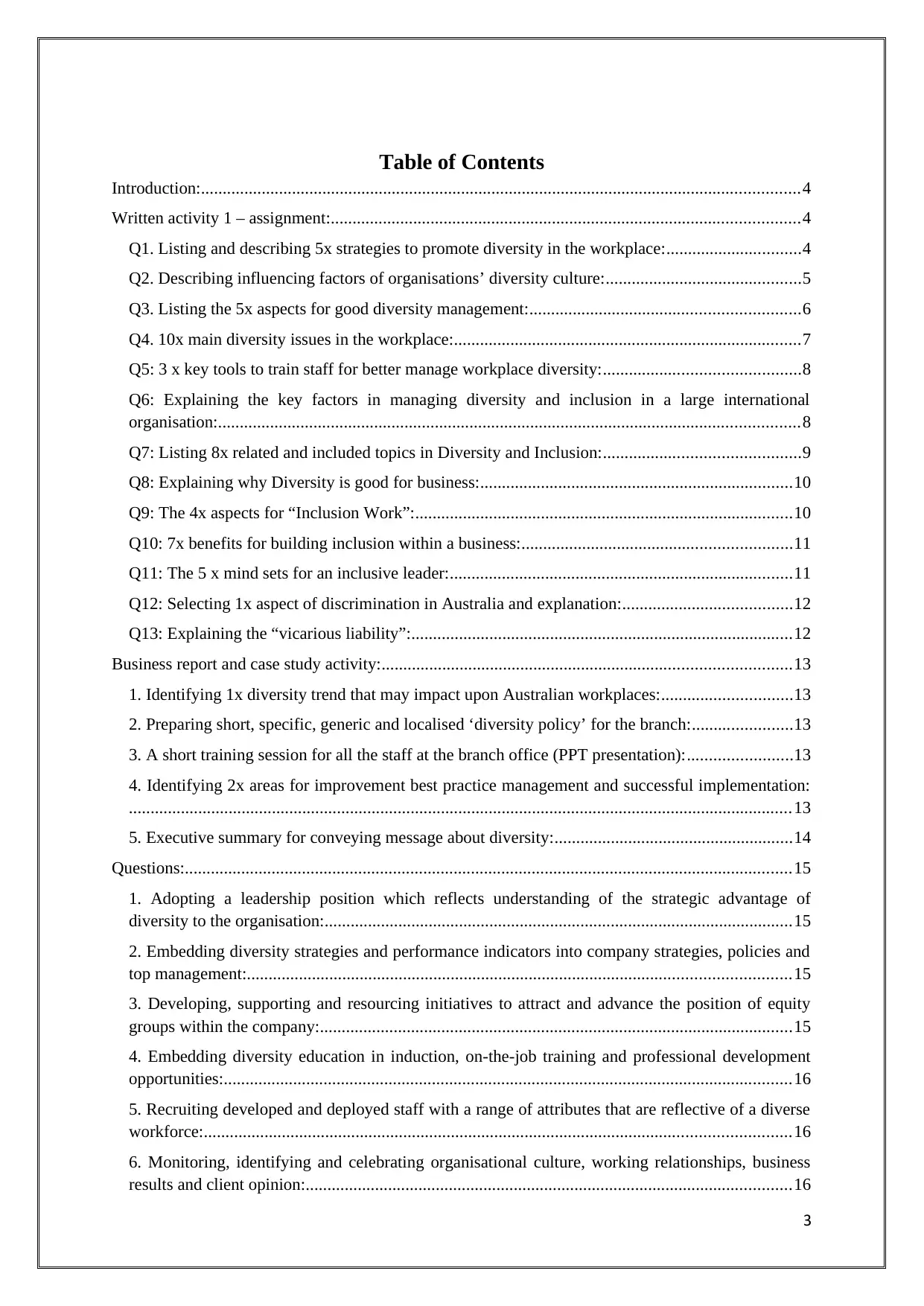
Table of Contents
Introduction:..........................................................................................................................................4
Written activity 1 – assignment:............................................................................................................4
Q1. Listing and describing 5x strategies to promote diversity in the workplace:...............................4
Q2. Describing influencing factors of organisations’ diversity culture:.............................................5
Q3. Listing the 5x aspects for good diversity management:..............................................................6
Q4. 10x main diversity issues in the workplace:................................................................................7
Q5: 3 x key tools to train staff for better manage workplace diversity:.............................................8
Q6: Explaining the key factors in managing diversity and inclusion in a large international
organisation:......................................................................................................................................8
Q7: Listing 8x related and included topics in Diversity and Inclusion:.............................................9
Q8: Explaining why Diversity is good for business:........................................................................10
Q9: The 4x aspects for “Inclusion Work”:.......................................................................................10
Q10: 7x benefits for building inclusion within a business:..............................................................11
Q11: The 5 x mind sets for an inclusive leader:...............................................................................11
Q12: Selecting 1x aspect of discrimination in Australia and explanation:.......................................12
Q13: Explaining the “vicarious liability”:........................................................................................12
Business report and case study activity:..............................................................................................13
1. Identifying 1x diversity trend that may impact upon Australian workplaces:..............................13
2. Preparing short, specific, generic and localised ‘diversity policy’ for the branch:.......................13
3. A short training session for all the staff at the branch office (PPT presentation):........................13
4. Identifying 2x areas for improvement best practice management and successful implementation:
.........................................................................................................................................................13
5. Executive summary for conveying message about diversity:.......................................................14
Questions:............................................................................................................................................15
1. Adopting a leadership position which reflects understanding of the strategic advantage of
diversity to the organisation:............................................................................................................15
2. Embedding diversity strategies and performance indicators into company strategies, policies and
top management:.............................................................................................................................15
3. Developing, supporting and resourcing initiatives to attract and advance the position of equity
groups within the company:.............................................................................................................15
4. Embedding diversity education in induction, on-the-job training and professional development
opportunities:...................................................................................................................................16
5. Recruiting developed and deployed staff with a range of attributes that are reflective of a diverse
workforce:.......................................................................................................................................16
6. Monitoring, identifying and celebrating organisational culture, working relationships, business
results and client opinion:................................................................................................................16
3
Introduction:..........................................................................................................................................4
Written activity 1 – assignment:............................................................................................................4
Q1. Listing and describing 5x strategies to promote diversity in the workplace:...............................4
Q2. Describing influencing factors of organisations’ diversity culture:.............................................5
Q3. Listing the 5x aspects for good diversity management:..............................................................6
Q4. 10x main diversity issues in the workplace:................................................................................7
Q5: 3 x key tools to train staff for better manage workplace diversity:.............................................8
Q6: Explaining the key factors in managing diversity and inclusion in a large international
organisation:......................................................................................................................................8
Q7: Listing 8x related and included topics in Diversity and Inclusion:.............................................9
Q8: Explaining why Diversity is good for business:........................................................................10
Q9: The 4x aspects for “Inclusion Work”:.......................................................................................10
Q10: 7x benefits for building inclusion within a business:..............................................................11
Q11: The 5 x mind sets for an inclusive leader:...............................................................................11
Q12: Selecting 1x aspect of discrimination in Australia and explanation:.......................................12
Q13: Explaining the “vicarious liability”:........................................................................................12
Business report and case study activity:..............................................................................................13
1. Identifying 1x diversity trend that may impact upon Australian workplaces:..............................13
2. Preparing short, specific, generic and localised ‘diversity policy’ for the branch:.......................13
3. A short training session for all the staff at the branch office (PPT presentation):........................13
4. Identifying 2x areas for improvement best practice management and successful implementation:
.........................................................................................................................................................13
5. Executive summary for conveying message about diversity:.......................................................14
Questions:............................................................................................................................................15
1. Adopting a leadership position which reflects understanding of the strategic advantage of
diversity to the organisation:............................................................................................................15
2. Embedding diversity strategies and performance indicators into company strategies, policies and
top management:.............................................................................................................................15
3. Developing, supporting and resourcing initiatives to attract and advance the position of equity
groups within the company:.............................................................................................................15
4. Embedding diversity education in induction, on-the-job training and professional development
opportunities:...................................................................................................................................16
5. Recruiting developed and deployed staff with a range of attributes that are reflective of a diverse
workforce:.......................................................................................................................................16
6. Monitoring, identifying and celebrating organisational culture, working relationships, business
results and client opinion:................................................................................................................16
3
⊘ This is a preview!⊘
Do you want full access?
Subscribe today to unlock all pages.

Trusted by 1+ million students worldwide
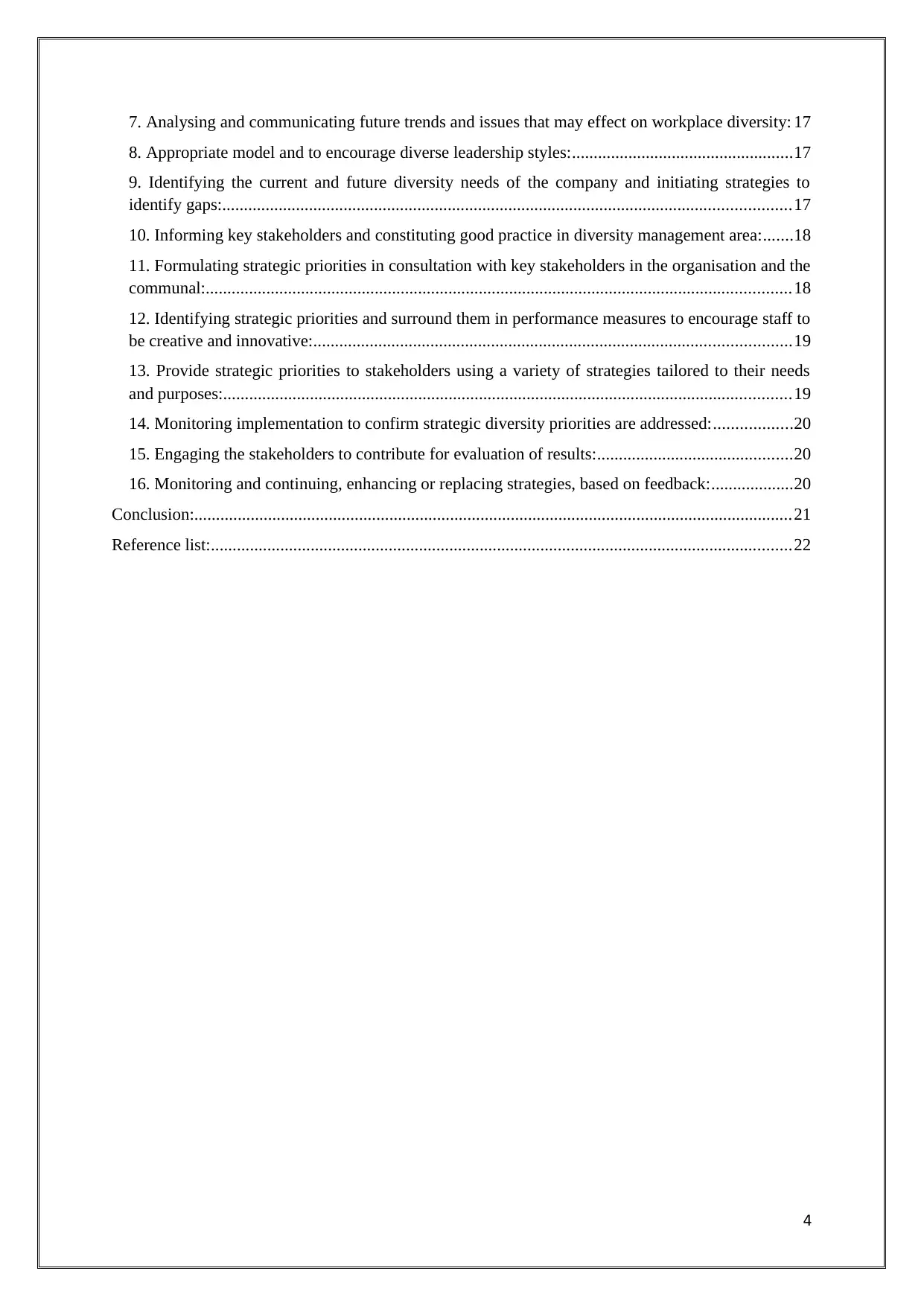
7. Analysing and communicating future trends and issues that may effect on workplace diversity: 17
8. Appropriate model and to encourage diverse leadership styles:...................................................17
9. Identifying the current and future diversity needs of the company and initiating strategies to
identify gaps:...................................................................................................................................17
10. Informing key stakeholders and constituting good practice in diversity management area:.......18
11. Formulating strategic priorities in consultation with key stakeholders in the organisation and the
communal:.......................................................................................................................................18
12. Identifying strategic priorities and surround them in performance measures to encourage staff to
be creative and innovative:..............................................................................................................19
13. Provide strategic priorities to stakeholders using a variety of strategies tailored to their needs
and purposes:...................................................................................................................................19
14. Monitoring implementation to confirm strategic diversity priorities are addressed:..................20
15. Engaging the stakeholders to contribute for evaluation of results:.............................................20
16. Monitoring and continuing, enhancing or replacing strategies, based on feedback:...................20
Conclusion:..........................................................................................................................................21
Reference list:......................................................................................................................................22
4
8. Appropriate model and to encourage diverse leadership styles:...................................................17
9. Identifying the current and future diversity needs of the company and initiating strategies to
identify gaps:...................................................................................................................................17
10. Informing key stakeholders and constituting good practice in diversity management area:.......18
11. Formulating strategic priorities in consultation with key stakeholders in the organisation and the
communal:.......................................................................................................................................18
12. Identifying strategic priorities and surround them in performance measures to encourage staff to
be creative and innovative:..............................................................................................................19
13. Provide strategic priorities to stakeholders using a variety of strategies tailored to their needs
and purposes:...................................................................................................................................19
14. Monitoring implementation to confirm strategic diversity priorities are addressed:..................20
15. Engaging the stakeholders to contribute for evaluation of results:.............................................20
16. Monitoring and continuing, enhancing or replacing strategies, based on feedback:...................20
Conclusion:..........................................................................................................................................21
Reference list:......................................................................................................................................22
4
Paraphrase This Document
Need a fresh take? Get an instant paraphrase of this document with our AI Paraphraser
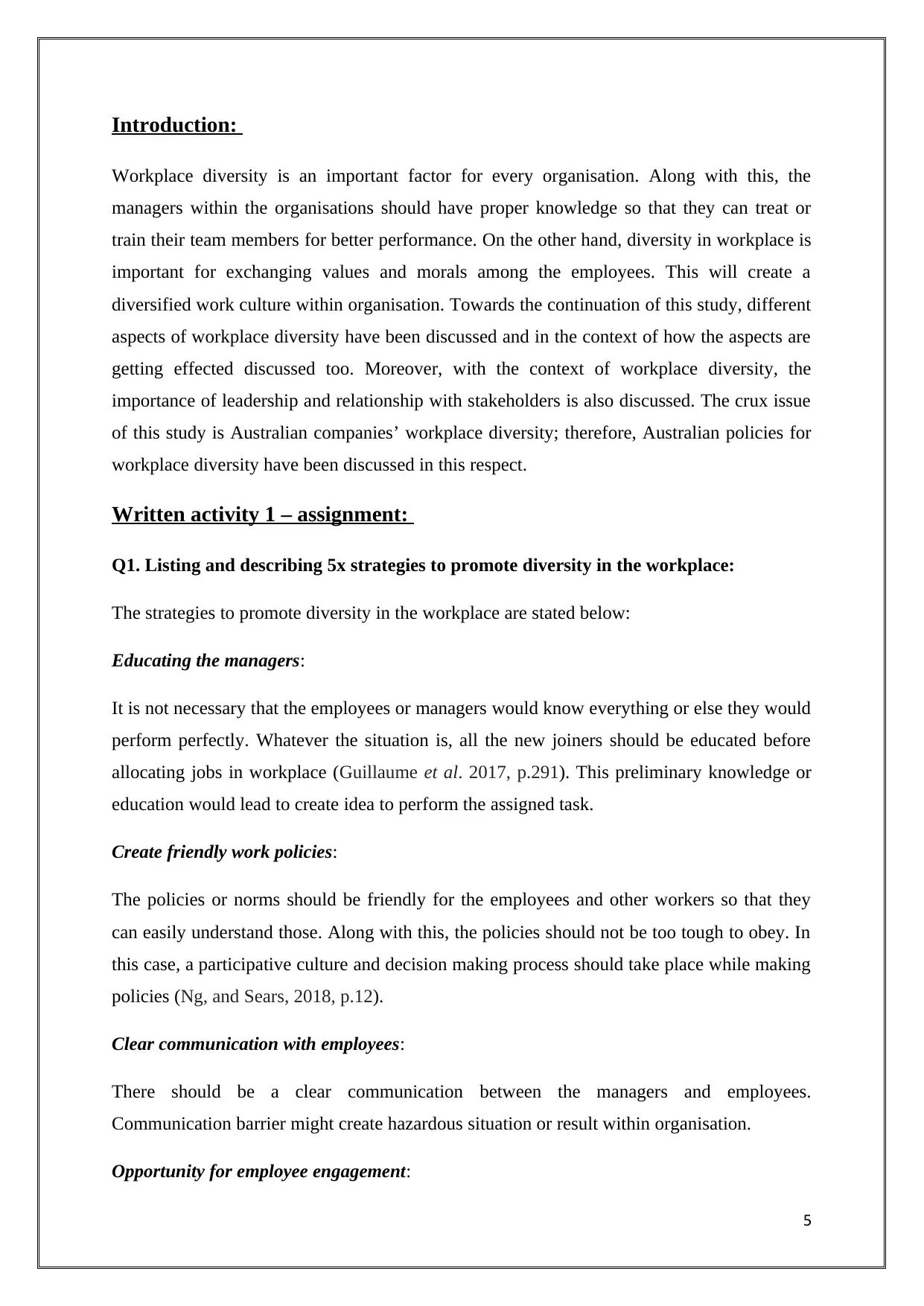
Introduction:
Workplace diversity is an important factor for every organisation. Along with this, the
managers within the organisations should have proper knowledge so that they can treat or
train their team members for better performance. On the other hand, diversity in workplace is
important for exchanging values and morals among the employees. This will create a
diversified work culture within organisation. Towards the continuation of this study, different
aspects of workplace diversity have been discussed and in the context of how the aspects are
getting effected discussed too. Moreover, with the context of workplace diversity, the
importance of leadership and relationship with stakeholders is also discussed. The crux issue
of this study is Australian companies’ workplace diversity; therefore, Australian policies for
workplace diversity have been discussed in this respect.
Written activity 1 – assignment:
Q1. Listing and describing 5x strategies to promote diversity in the workplace:
The strategies to promote diversity in the workplace are stated below:
Educating the managers:
It is not necessary that the employees or managers would know everything or else they would
perform perfectly. Whatever the situation is, all the new joiners should be educated before
allocating jobs in workplace (Guillaume et al. 2017, p.291). This preliminary knowledge or
education would lead to create idea to perform the assigned task.
Create friendly work policies:
The policies or norms should be friendly for the employees and other workers so that they
can easily understand those. Along with this, the policies should not be too tough to obey. In
this case, a participative culture and decision making process should take place while making
policies (Ng, and Sears, 2018, p.12).
Clear communication with employees:
There should be a clear communication between the managers and employees.
Communication barrier might create hazardous situation or result within organisation.
Opportunity for employee engagement:
5
Workplace diversity is an important factor for every organisation. Along with this, the
managers within the organisations should have proper knowledge so that they can treat or
train their team members for better performance. On the other hand, diversity in workplace is
important for exchanging values and morals among the employees. This will create a
diversified work culture within organisation. Towards the continuation of this study, different
aspects of workplace diversity have been discussed and in the context of how the aspects are
getting effected discussed too. Moreover, with the context of workplace diversity, the
importance of leadership and relationship with stakeholders is also discussed. The crux issue
of this study is Australian companies’ workplace diversity; therefore, Australian policies for
workplace diversity have been discussed in this respect.
Written activity 1 – assignment:
Q1. Listing and describing 5x strategies to promote diversity in the workplace:
The strategies to promote diversity in the workplace are stated below:
Educating the managers:
It is not necessary that the employees or managers would know everything or else they would
perform perfectly. Whatever the situation is, all the new joiners should be educated before
allocating jobs in workplace (Guillaume et al. 2017, p.291). This preliminary knowledge or
education would lead to create idea to perform the assigned task.
Create friendly work policies:
The policies or norms should be friendly for the employees and other workers so that they
can easily understand those. Along with this, the policies should not be too tough to obey. In
this case, a participative culture and decision making process should take place while making
policies (Ng, and Sears, 2018, p.12).
Clear communication with employees:
There should be a clear communication between the managers and employees.
Communication barrier might create hazardous situation or result within organisation.
Opportunity for employee engagement:
5
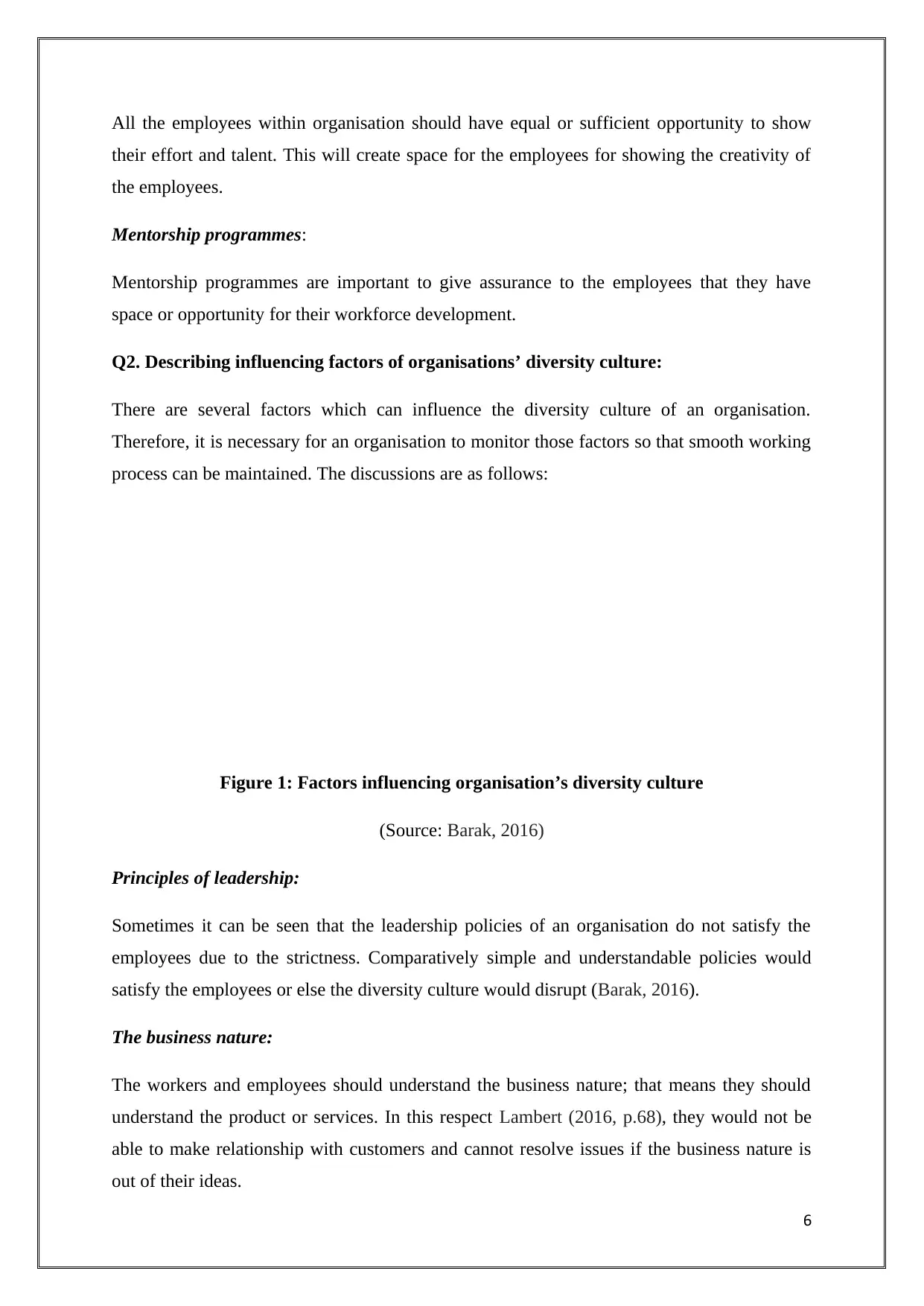
All the employees within organisation should have equal or sufficient opportunity to show
their effort and talent. This will create space for the employees for showing the creativity of
the employees.
Mentorship programmes:
Mentorship programmes are important to give assurance to the employees that they have
space or opportunity for their workforce development.
Q2. Describing influencing factors of organisations’ diversity culture:
There are several factors which can influence the diversity culture of an organisation.
Therefore, it is necessary for an organisation to monitor those factors so that smooth working
process can be maintained. The discussions are as follows:
Figure 1: Factors influencing organisation’s diversity culture
(Source: Barak, 2016)
Principles of leadership:
Sometimes it can be seen that the leadership policies of an organisation do not satisfy the
employees due to the strictness. Comparatively simple and understandable policies would
satisfy the employees or else the diversity culture would disrupt (Barak, 2016).
The business nature:
The workers and employees should understand the business nature; that means they should
understand the product or services. In this respect Lambert (2016, p.68), they would not be
able to make relationship with customers and cannot resolve issues if the business nature is
out of their ideas.
6
FactorsinfluencingdiversityLeadershipprinciplesBusinessnatureRelationshipwithstakeholders
their effort and talent. This will create space for the employees for showing the creativity of
the employees.
Mentorship programmes:
Mentorship programmes are important to give assurance to the employees that they have
space or opportunity for their workforce development.
Q2. Describing influencing factors of organisations’ diversity culture:
There are several factors which can influence the diversity culture of an organisation.
Therefore, it is necessary for an organisation to monitor those factors so that smooth working
process can be maintained. The discussions are as follows:
Figure 1: Factors influencing organisation’s diversity culture
(Source: Barak, 2016)
Principles of leadership:
Sometimes it can be seen that the leadership policies of an organisation do not satisfy the
employees due to the strictness. Comparatively simple and understandable policies would
satisfy the employees or else the diversity culture would disrupt (Barak, 2016).
The business nature:
The workers and employees should understand the business nature; that means they should
understand the product or services. In this respect Lambert (2016, p.68), they would not be
able to make relationship with customers and cannot resolve issues if the business nature is
out of their ideas.
6
FactorsinfluencingdiversityLeadershipprinciplesBusinessnatureRelationshipwithstakeholders
⊘ This is a preview!⊘
Do you want full access?
Subscribe today to unlock all pages.

Trusted by 1+ million students worldwide
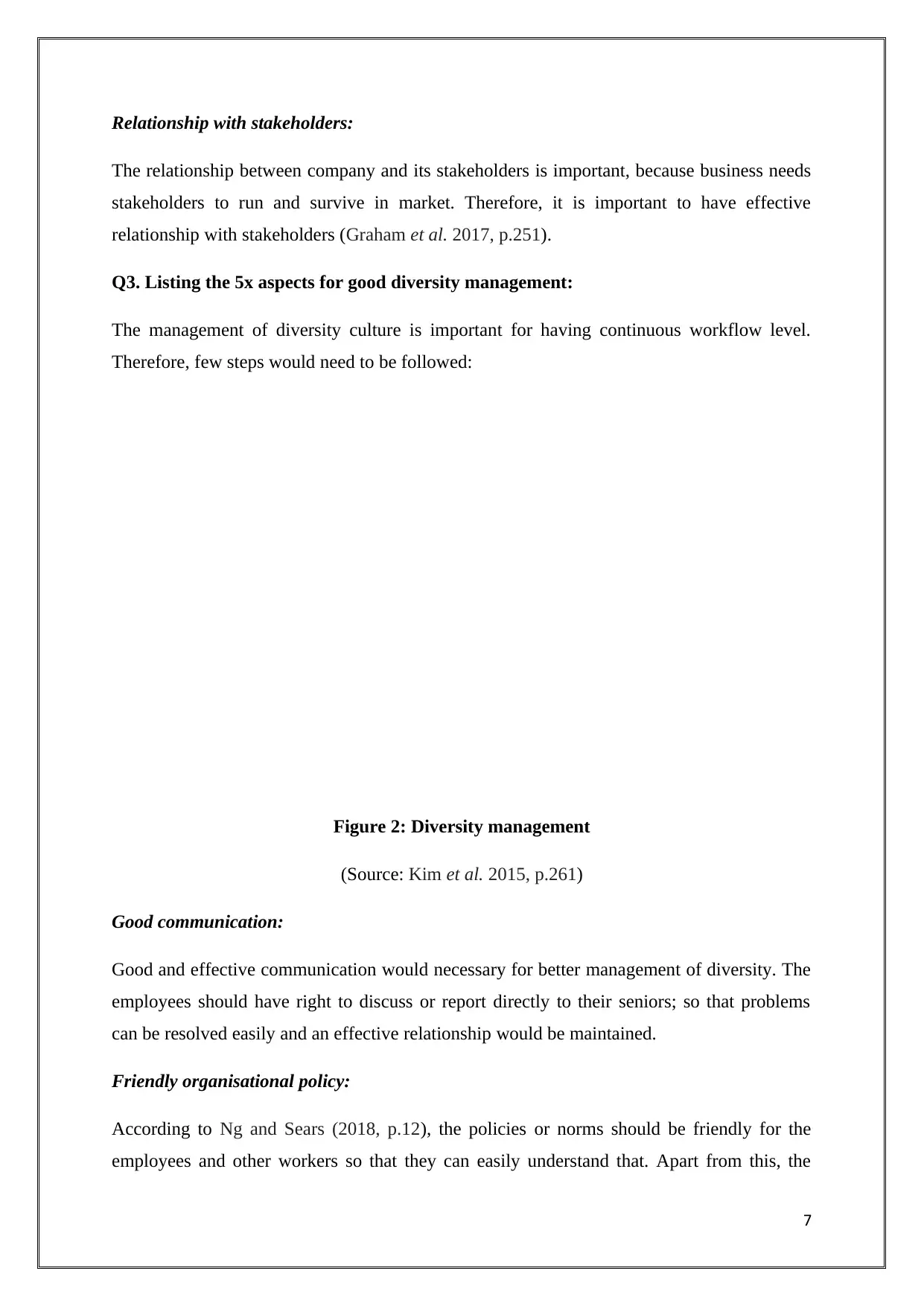
Relationship with stakeholders:
The relationship between company and its stakeholders is important, because business needs
stakeholders to run and survive in market. Therefore, it is important to have effective
relationship with stakeholders (Graham et al. 2017, p.251).
Q3. Listing the 5x aspects for good diversity management:
The management of diversity culture is important for having continuous workflow level.
Therefore, few steps would need to be followed:
Figure 2: Diversity management
(Source: Kim et al. 2015, p.261)
Good communication:
Good and effective communication would necessary for better management of diversity. The
employees should have right to discuss or report directly to their seniors; so that problems
can be resolved easily and an effective relationship would be maintained.
Friendly organisational policy:
According to Ng and Sears (2018, p.12), the policies or norms should be friendly for the
employees and other workers so that they can easily understand that. Apart from this, the
7
ManagementofdiversityCommunicationFriendlypolicyParticipativeleaderOpenmindedObjectivebasedwork
The relationship between company and its stakeholders is important, because business needs
stakeholders to run and survive in market. Therefore, it is important to have effective
relationship with stakeholders (Graham et al. 2017, p.251).
Q3. Listing the 5x aspects for good diversity management:
The management of diversity culture is important for having continuous workflow level.
Therefore, few steps would need to be followed:
Figure 2: Diversity management
(Source: Kim et al. 2015, p.261)
Good communication:
Good and effective communication would necessary for better management of diversity. The
employees should have right to discuss or report directly to their seniors; so that problems
can be resolved easily and an effective relationship would be maintained.
Friendly organisational policy:
According to Ng and Sears (2018, p.12), the policies or norms should be friendly for the
employees and other workers so that they can easily understand that. Apart from this, the
7
ManagementofdiversityCommunicationFriendlypolicyParticipativeleaderOpenmindedObjectivebasedwork
Paraphrase This Document
Need a fresh take? Get an instant paraphrase of this document with our AI Paraphraser
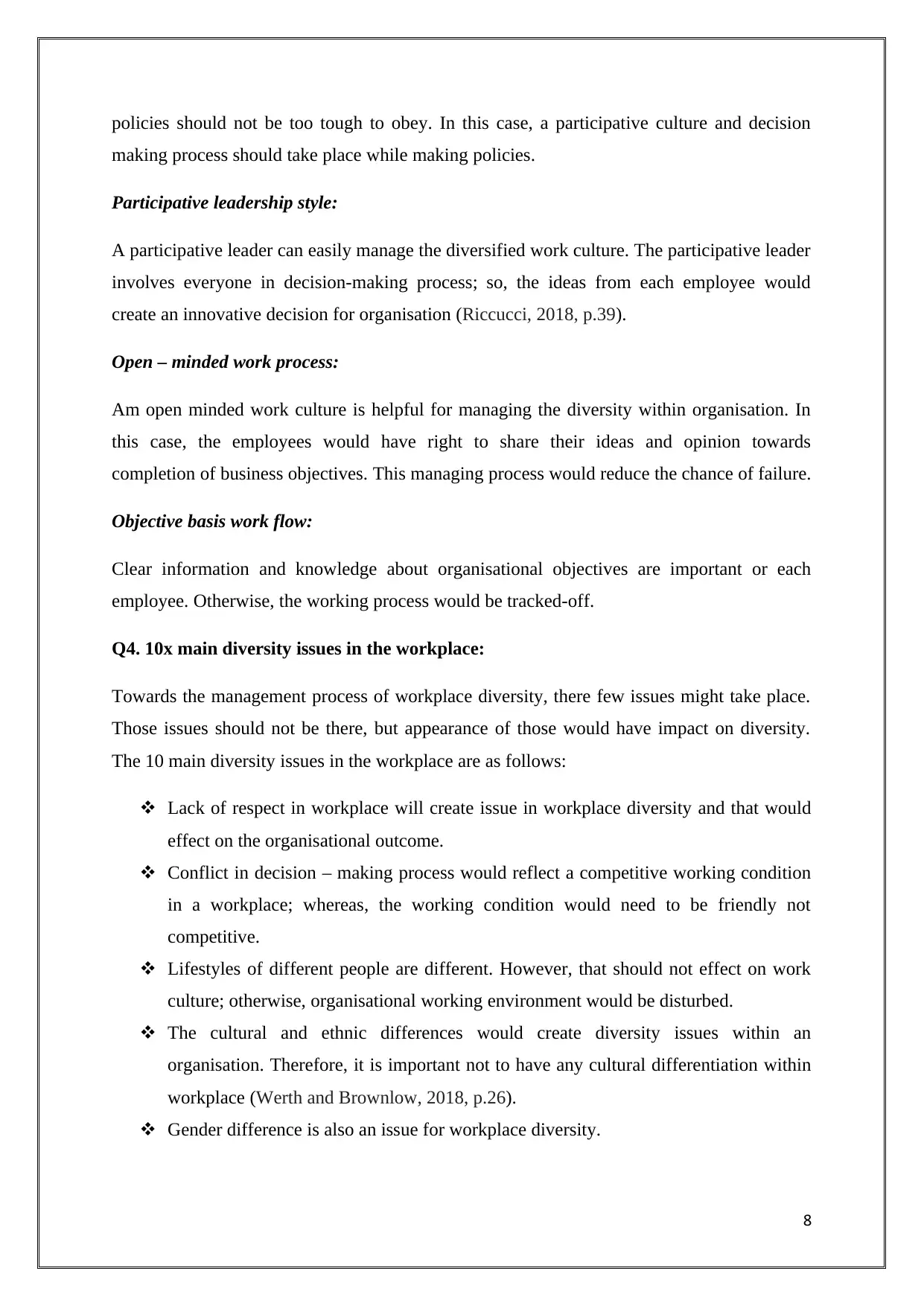
policies should not be too tough to obey. In this case, a participative culture and decision
making process should take place while making policies.
Participative leadership style:
A participative leader can easily manage the diversified work culture. The participative leader
involves everyone in decision-making process; so, the ideas from each employee would
create an innovative decision for organisation (Riccucci, 2018, p.39).
Open – minded work process:
Am open minded work culture is helpful for managing the diversity within organisation. In
this case, the employees would have right to share their ideas and opinion towards
completion of business objectives. This managing process would reduce the chance of failure.
Objective basis work flow:
Clear information and knowledge about organisational objectives are important or each
employee. Otherwise, the working process would be tracked-off.
Q4. 10x main diversity issues in the workplace:
Towards the management process of workplace diversity, there few issues might take place.
Those issues should not be there, but appearance of those would have impact on diversity.
The 10 main diversity issues in the workplace are as follows:
Lack of respect in workplace will create issue in workplace diversity and that would
effect on the organisational outcome.
Conflict in decision – making process would reflect a competitive working condition
in a workplace; whereas, the working condition would need to be friendly not
competitive.
Lifestyles of different people are different. However, that should not effect on work
culture; otherwise, organisational working environment would be disturbed.
The cultural and ethnic differences would create diversity issues within an
organisation. Therefore, it is important not to have any cultural differentiation within
workplace (Werth and Brownlow, 2018, p.26).
Gender difference is also an issue for workplace diversity.
8
making process should take place while making policies.
Participative leadership style:
A participative leader can easily manage the diversified work culture. The participative leader
involves everyone in decision-making process; so, the ideas from each employee would
create an innovative decision for organisation (Riccucci, 2018, p.39).
Open – minded work process:
Am open minded work culture is helpful for managing the diversity within organisation. In
this case, the employees would have right to share their ideas and opinion towards
completion of business objectives. This managing process would reduce the chance of failure.
Objective basis work flow:
Clear information and knowledge about organisational objectives are important or each
employee. Otherwise, the working process would be tracked-off.
Q4. 10x main diversity issues in the workplace:
Towards the management process of workplace diversity, there few issues might take place.
Those issues should not be there, but appearance of those would have impact on diversity.
The 10 main diversity issues in the workplace are as follows:
Lack of respect in workplace will create issue in workplace diversity and that would
effect on the organisational outcome.
Conflict in decision – making process would reflect a competitive working condition
in a workplace; whereas, the working condition would need to be friendly not
competitive.
Lifestyles of different people are different. However, that should not effect on work
culture; otherwise, organisational working environment would be disturbed.
The cultural and ethnic differences would create diversity issues within an
organisation. Therefore, it is important not to have any cultural differentiation within
workplace (Werth and Brownlow, 2018, p.26).
Gender difference is also an issue for workplace diversity.
8
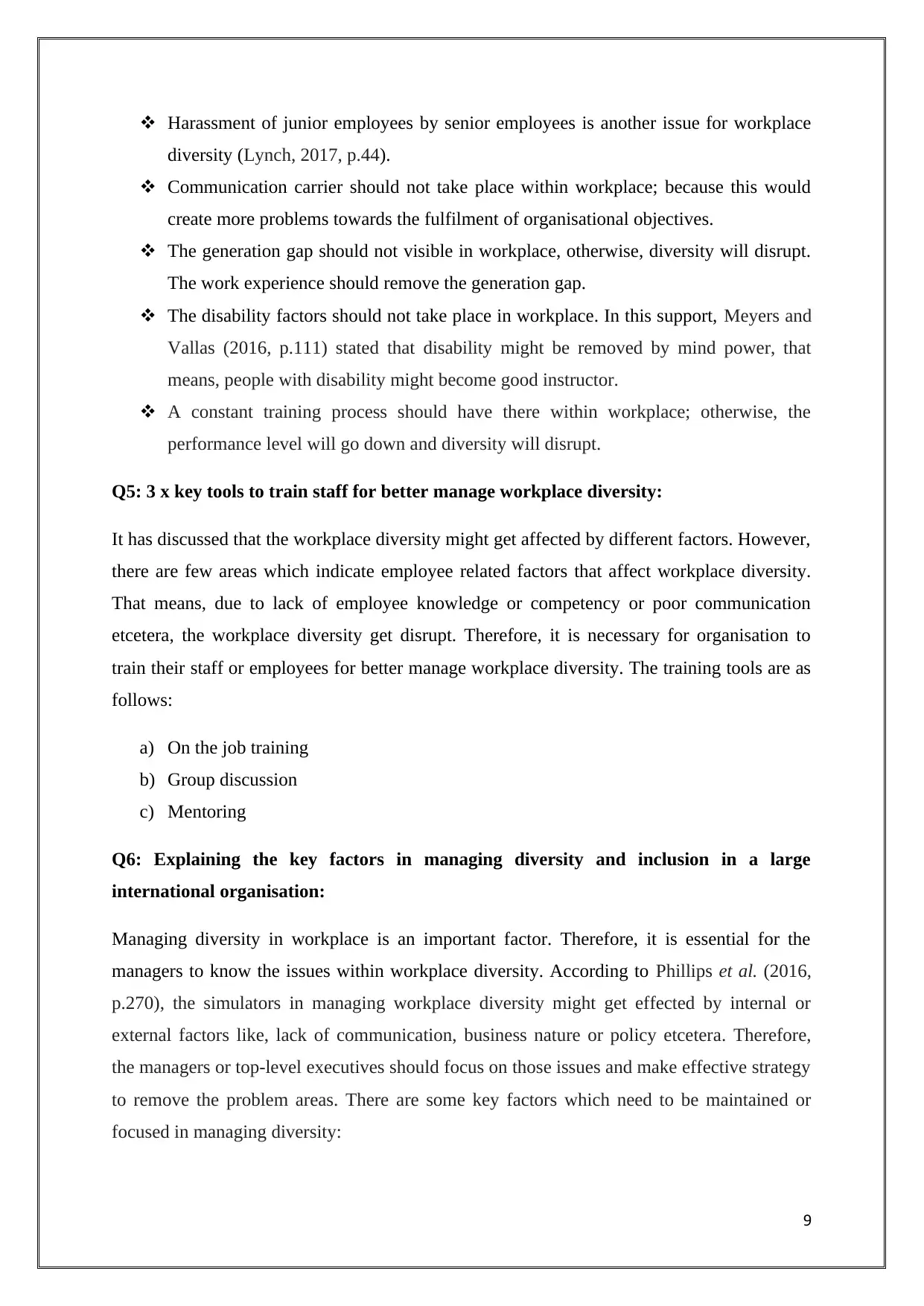
Harassment of junior employees by senior employees is another issue for workplace
diversity (Lynch, 2017, p.44).
Communication carrier should not take place within workplace; because this would
create more problems towards the fulfilment of organisational objectives.
The generation gap should not visible in workplace, otherwise, diversity will disrupt.
The work experience should remove the generation gap.
The disability factors should not take place in workplace. In this support, Meyers and
Vallas (2016, p.111) stated that disability might be removed by mind power, that
means, people with disability might become good instructor.
A constant training process should have there within workplace; otherwise, the
performance level will go down and diversity will disrupt.
Q5: 3 x key tools to train staff for better manage workplace diversity:
It has discussed that the workplace diversity might get affected by different factors. However,
there are few areas which indicate employee related factors that affect workplace diversity.
That means, due to lack of employee knowledge or competency or poor communication
etcetera, the workplace diversity get disrupt. Therefore, it is necessary for organisation to
train their staff or employees for better manage workplace diversity. The training tools are as
follows:
a) On the job training
b) Group discussion
c) Mentoring
Q6: Explaining the key factors in managing diversity and inclusion in a large
international organisation:
Managing diversity in workplace is an important factor. Therefore, it is essential for the
managers to know the issues within workplace diversity. According to Phillips et al. (2016,
p.270), the simulators in managing workplace diversity might get effected by internal or
external factors like, lack of communication, business nature or policy etcetera. Therefore,
the managers or top-level executives should focus on those issues and make effective strategy
to remove the problem areas. There are some key factors which need to be maintained or
focused in managing diversity:
9
diversity (Lynch, 2017, p.44).
Communication carrier should not take place within workplace; because this would
create more problems towards the fulfilment of organisational objectives.
The generation gap should not visible in workplace, otherwise, diversity will disrupt.
The work experience should remove the generation gap.
The disability factors should not take place in workplace. In this support, Meyers and
Vallas (2016, p.111) stated that disability might be removed by mind power, that
means, people with disability might become good instructor.
A constant training process should have there within workplace; otherwise, the
performance level will go down and diversity will disrupt.
Q5: 3 x key tools to train staff for better manage workplace diversity:
It has discussed that the workplace diversity might get affected by different factors. However,
there are few areas which indicate employee related factors that affect workplace diversity.
That means, due to lack of employee knowledge or competency or poor communication
etcetera, the workplace diversity get disrupt. Therefore, it is necessary for organisation to
train their staff or employees for better manage workplace diversity. The training tools are as
follows:
a) On the job training
b) Group discussion
c) Mentoring
Q6: Explaining the key factors in managing diversity and inclusion in a large
international organisation:
Managing diversity in workplace is an important factor. Therefore, it is essential for the
managers to know the issues within workplace diversity. According to Phillips et al. (2016,
p.270), the simulators in managing workplace diversity might get effected by internal or
external factors like, lack of communication, business nature or policy etcetera. Therefore,
the managers or top-level executives should focus on those issues and make effective strategy
to remove the problem areas. There are some key factors which need to be maintained or
focused in managing diversity:
9
⊘ This is a preview!⊘
Do you want full access?
Subscribe today to unlock all pages.

Trusted by 1+ million students worldwide
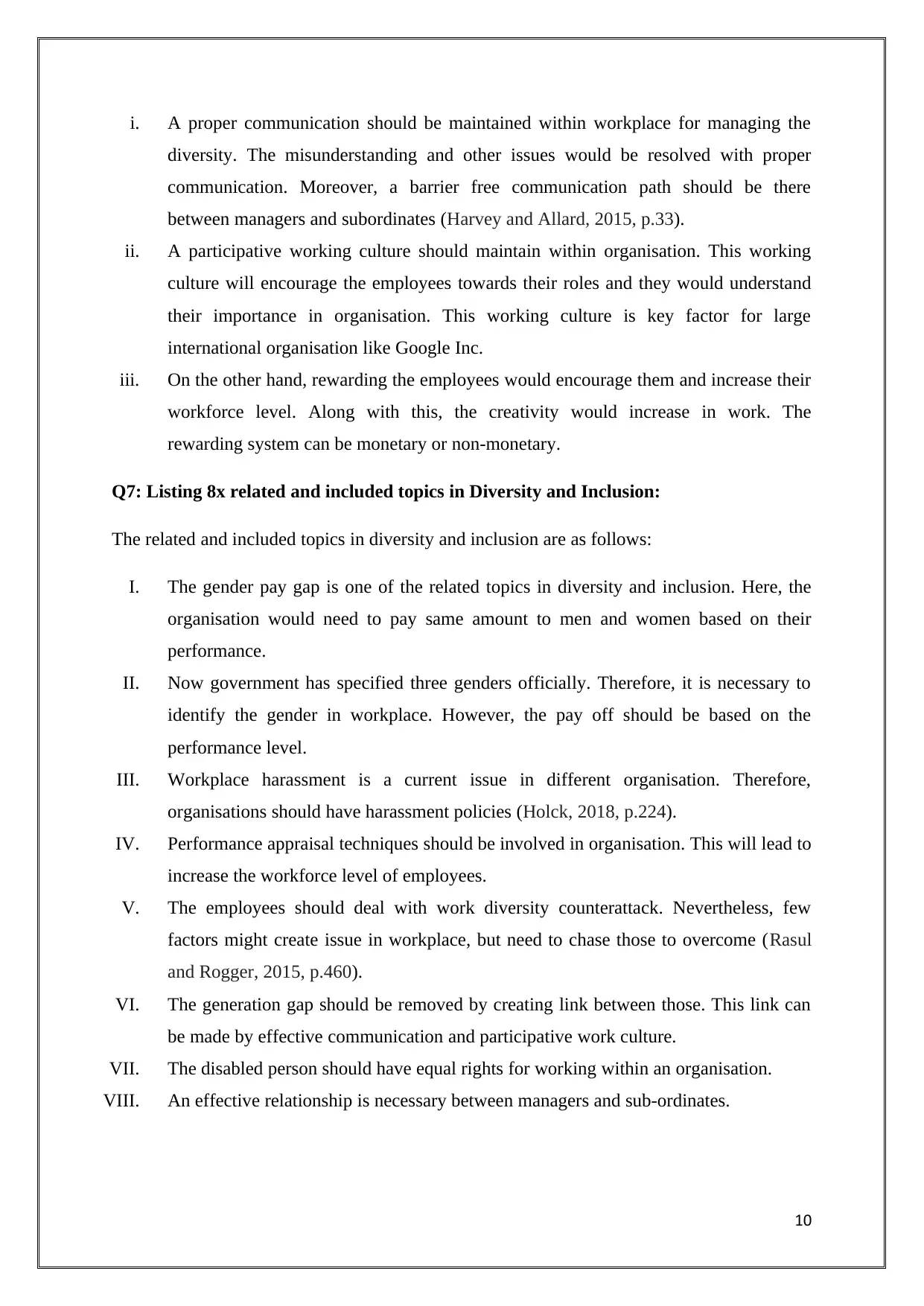
i. A proper communication should be maintained within workplace for managing the
diversity. The misunderstanding and other issues would be resolved with proper
communication. Moreover, a barrier free communication path should be there
between managers and subordinates (Harvey and Allard, 2015, p.33).
ii. A participative working culture should maintain within organisation. This working
culture will encourage the employees towards their roles and they would understand
their importance in organisation. This working culture is key factor for large
international organisation like Google Inc.
iii. On the other hand, rewarding the employees would encourage them and increase their
workforce level. Along with this, the creativity would increase in work. The
rewarding system can be monetary or non-monetary.
Q7: Listing 8x related and included topics in Diversity and Inclusion:
The related and included topics in diversity and inclusion are as follows:
I. The gender pay gap is one of the related topics in diversity and inclusion. Here, the
organisation would need to pay same amount to men and women based on their
performance.
II. Now government has specified three genders officially. Therefore, it is necessary to
identify the gender in workplace. However, the pay off should be based on the
performance level.
III. Workplace harassment is a current issue in different organisation. Therefore,
organisations should have harassment policies (Holck, 2018, p.224).
IV. Performance appraisal techniques should be involved in organisation. This will lead to
increase the workforce level of employees.
V. The employees should deal with work diversity counterattack. Nevertheless, few
factors might create issue in workplace, but need to chase those to overcome (Rasul
and Rogger, 2015, p.460).
VI. The generation gap should be removed by creating link between those. This link can
be made by effective communication and participative work culture.
VII. The disabled person should have equal rights for working within an organisation.
VIII. An effective relationship is necessary between managers and sub-ordinates.
10
diversity. The misunderstanding and other issues would be resolved with proper
communication. Moreover, a barrier free communication path should be there
between managers and subordinates (Harvey and Allard, 2015, p.33).
ii. A participative working culture should maintain within organisation. This working
culture will encourage the employees towards their roles and they would understand
their importance in organisation. This working culture is key factor for large
international organisation like Google Inc.
iii. On the other hand, rewarding the employees would encourage them and increase their
workforce level. Along with this, the creativity would increase in work. The
rewarding system can be monetary or non-monetary.
Q7: Listing 8x related and included topics in Diversity and Inclusion:
The related and included topics in diversity and inclusion are as follows:
I. The gender pay gap is one of the related topics in diversity and inclusion. Here, the
organisation would need to pay same amount to men and women based on their
performance.
II. Now government has specified three genders officially. Therefore, it is necessary to
identify the gender in workplace. However, the pay off should be based on the
performance level.
III. Workplace harassment is a current issue in different organisation. Therefore,
organisations should have harassment policies (Holck, 2018, p.224).
IV. Performance appraisal techniques should be involved in organisation. This will lead to
increase the workforce level of employees.
V. The employees should deal with work diversity counterattack. Nevertheless, few
factors might create issue in workplace, but need to chase those to overcome (Rasul
and Rogger, 2015, p.460).
VI. The generation gap should be removed by creating link between those. This link can
be made by effective communication and participative work culture.
VII. The disabled person should have equal rights for working within an organisation.
VIII. An effective relationship is necessary between managers and sub-ordinates.
10
Paraphrase This Document
Need a fresh take? Get an instant paraphrase of this document with our AI Paraphraser
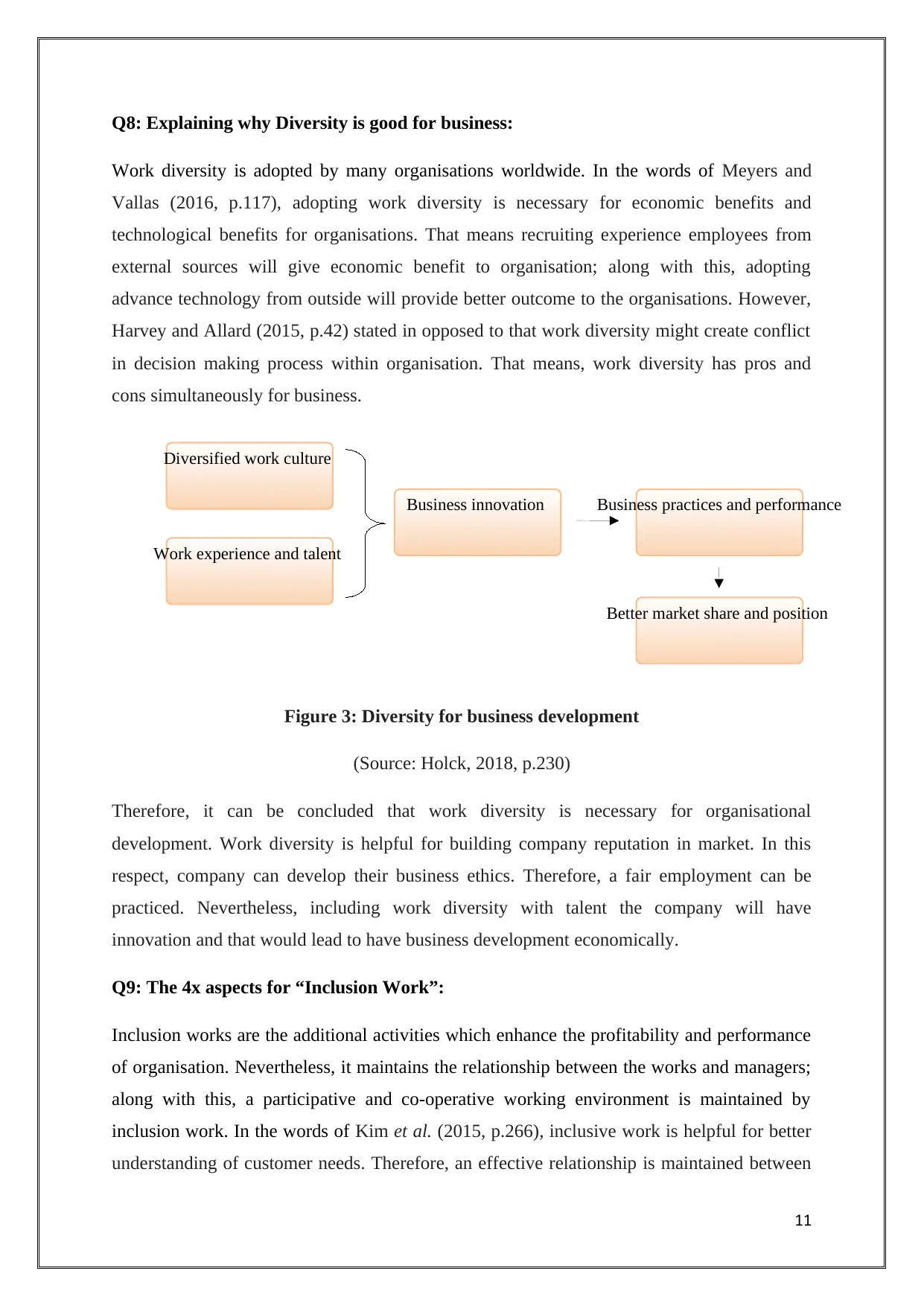
Diversified work culture
Work experience and talent
Business innovation Business practices and performance
Better market share and position
Q8: Explaining why Diversity is good for business:
Work diversity is adopted by many organisations worldwide. In the words of Meyers and
Vallas (2016, p.117), adopting work diversity is necessary for economic benefits and
technological benefits for organisations. That means recruiting experience employees from
external sources will give economic benefit to organisation; along with this, adopting
advance technology from outside will provide better outcome to the organisations. However,
Harvey and Allard (2015, p.42) stated in opposed to that work diversity might create conflict
in decision making process within organisation. That means, work diversity has pros and
cons simultaneously for business.
Figure 3: Diversity for business development
(Source: Holck, 2018, p.230)
Therefore, it can be concluded that work diversity is necessary for organisational
development. Work diversity is helpful for building company reputation in market. In this
respect, company can develop their business ethics. Therefore, a fair employment can be
practiced. Nevertheless, including work diversity with talent the company will have
innovation and that would lead to have business development economically.
Q9: The 4x aspects for “Inclusion Work”:
Inclusion works are the additional activities which enhance the profitability and performance
of organisation. Nevertheless, it maintains the relationship between the works and managers;
along with this, a participative and co-operative working environment is maintained by
inclusion work. In the words of Kim et al. (2015, p.266), inclusive work is helpful for better
understanding of customer needs. Therefore, an effective relationship is maintained between
11
Work experience and talent
Business innovation Business practices and performance
Better market share and position
Q8: Explaining why Diversity is good for business:
Work diversity is adopted by many organisations worldwide. In the words of Meyers and
Vallas (2016, p.117), adopting work diversity is necessary for economic benefits and
technological benefits for organisations. That means recruiting experience employees from
external sources will give economic benefit to organisation; along with this, adopting
advance technology from outside will provide better outcome to the organisations. However,
Harvey and Allard (2015, p.42) stated in opposed to that work diversity might create conflict
in decision making process within organisation. That means, work diversity has pros and
cons simultaneously for business.
Figure 3: Diversity for business development
(Source: Holck, 2018, p.230)
Therefore, it can be concluded that work diversity is necessary for organisational
development. Work diversity is helpful for building company reputation in market. In this
respect, company can develop their business ethics. Therefore, a fair employment can be
practiced. Nevertheless, including work diversity with talent the company will have
innovation and that would lead to have business development economically.
Q9: The 4x aspects for “Inclusion Work”:
Inclusion works are the additional activities which enhance the profitability and performance
of organisation. Nevertheless, it maintains the relationship between the works and managers;
along with this, a participative and co-operative working environment is maintained by
inclusion work. In the words of Kim et al. (2015, p.266), inclusive work is helpful for better
understanding of customer needs. Therefore, an effective relationship is maintained between
11
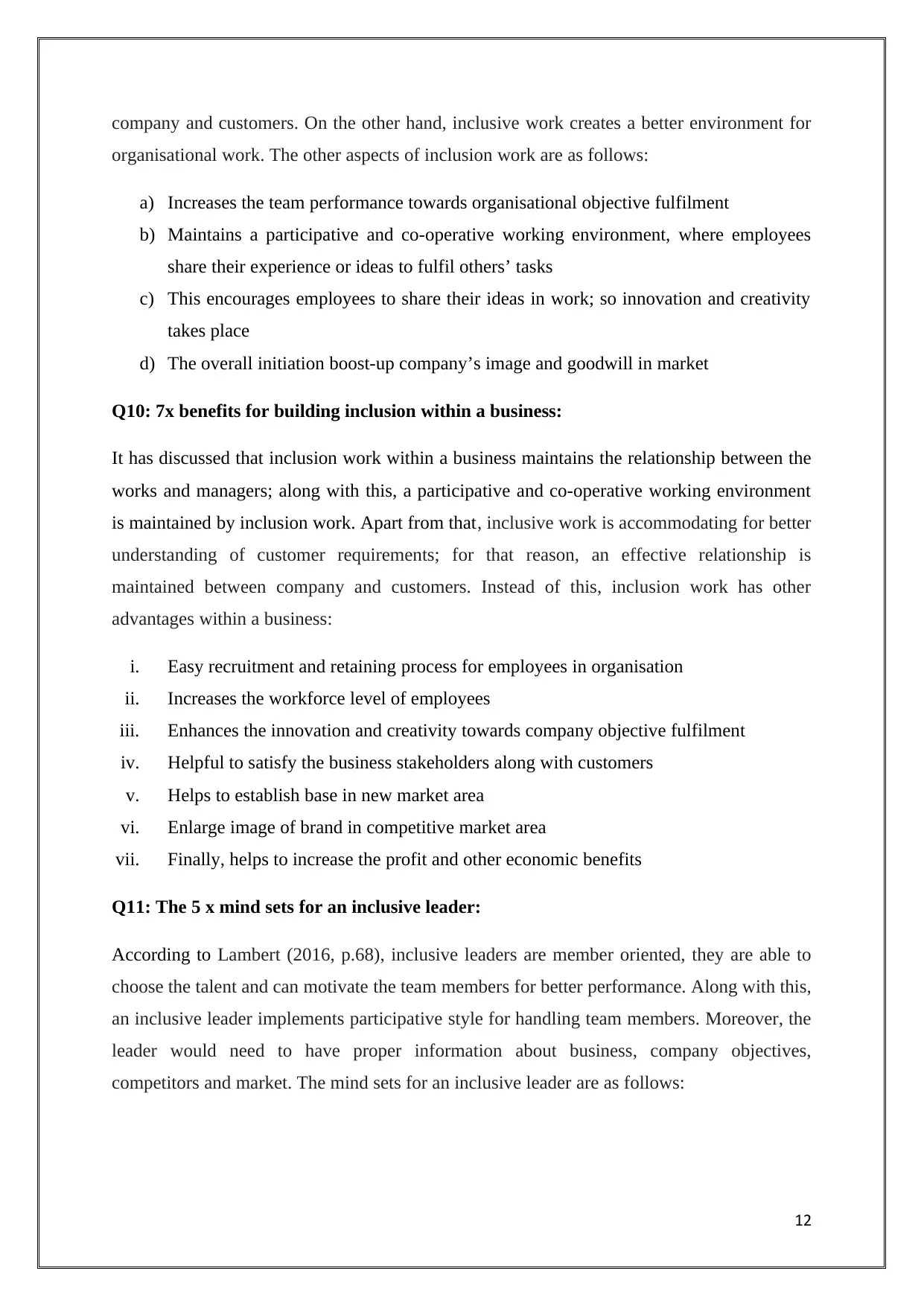
company and customers. On the other hand, inclusive work creates a better environment for
organisational work. The other aspects of inclusion work are as follows:
a) Increases the team performance towards organisational objective fulfilment
b) Maintains a participative and co-operative working environment, where employees
share their experience or ideas to fulfil others’ tasks
c) This encourages employees to share their ideas in work; so innovation and creativity
takes place
d) The overall initiation boost-up company’s image and goodwill in market
Q10: 7x benefits for building inclusion within a business:
It has discussed that inclusion work within a business maintains the relationship between the
works and managers; along with this, a participative and co-operative working environment
is maintained by inclusion work. Apart from that, inclusive work is accommodating for better
understanding of customer requirements; for that reason, an effective relationship is
maintained between company and customers. Instead of this, inclusion work has other
advantages within a business:
i. Easy recruitment and retaining process for employees in organisation
ii. Increases the workforce level of employees
iii. Enhances the innovation and creativity towards company objective fulfilment
iv. Helpful to satisfy the business stakeholders along with customers
v. Helps to establish base in new market area
vi. Enlarge image of brand in competitive market area
vii. Finally, helps to increase the profit and other economic benefits
Q11: The 5 x mind sets for an inclusive leader:
According to Lambert (2016, p.68), inclusive leaders are member oriented, they are able to
choose the talent and can motivate the team members for better performance. Along with this,
an inclusive leader implements participative style for handling team members. Moreover, the
leader would need to have proper information about business, company objectives,
competitors and market. The mind sets for an inclusive leader are as follows:
12
organisational work. The other aspects of inclusion work are as follows:
a) Increases the team performance towards organisational objective fulfilment
b) Maintains a participative and co-operative working environment, where employees
share their experience or ideas to fulfil others’ tasks
c) This encourages employees to share their ideas in work; so innovation and creativity
takes place
d) The overall initiation boost-up company’s image and goodwill in market
Q10: 7x benefits for building inclusion within a business:
It has discussed that inclusion work within a business maintains the relationship between the
works and managers; along with this, a participative and co-operative working environment
is maintained by inclusion work. Apart from that, inclusive work is accommodating for better
understanding of customer requirements; for that reason, an effective relationship is
maintained between company and customers. Instead of this, inclusion work has other
advantages within a business:
i. Easy recruitment and retaining process for employees in organisation
ii. Increases the workforce level of employees
iii. Enhances the innovation and creativity towards company objective fulfilment
iv. Helpful to satisfy the business stakeholders along with customers
v. Helps to establish base in new market area
vi. Enlarge image of brand in competitive market area
vii. Finally, helps to increase the profit and other economic benefits
Q11: The 5 x mind sets for an inclusive leader:
According to Lambert (2016, p.68), inclusive leaders are member oriented, they are able to
choose the talent and can motivate the team members for better performance. Along with this,
an inclusive leader implements participative style for handling team members. Moreover, the
leader would need to have proper information about business, company objectives,
competitors and market. The mind sets for an inclusive leader are as follows:
12
⊘ This is a preview!⊘
Do you want full access?
Subscribe today to unlock all pages.

Trusted by 1+ million students worldwide
1 out of 24
Related Documents
Your All-in-One AI-Powered Toolkit for Academic Success.
+13062052269
info@desklib.com
Available 24*7 on WhatsApp / Email
![[object Object]](/_next/static/media/star-bottom.7253800d.svg)
Unlock your academic potential
Copyright © 2020–2025 A2Z Services. All Rights Reserved. Developed and managed by ZUCOL.




